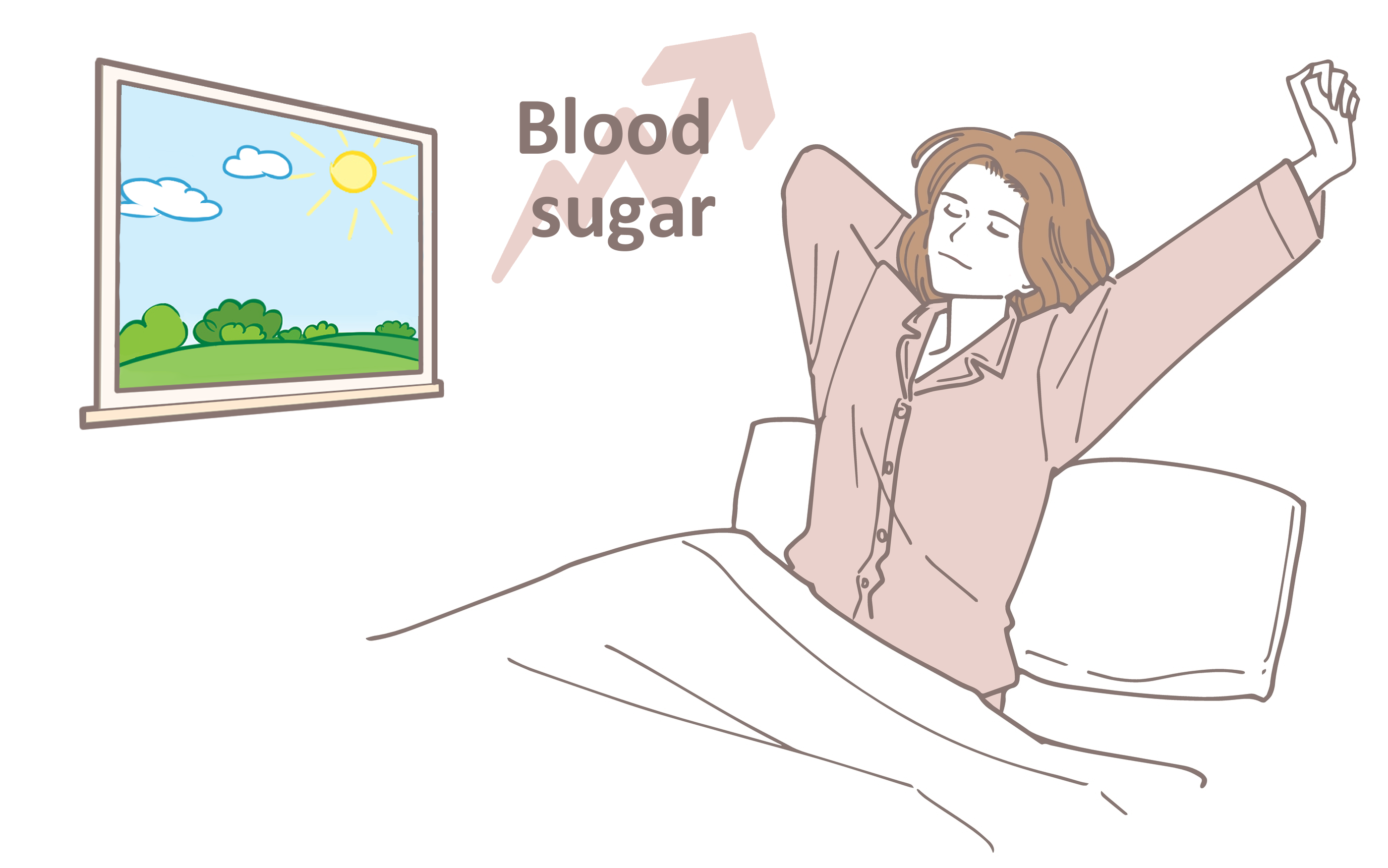Increased blood glucose levels in the morning are mostly attributable to what is known as the dawn phenomenon. The dawn phenomenon is a natural rise in blood sugar levels occurring in the early morning hours, typically between 2:00 am and 8:00 am.1,2 It is caused by the body releasing hormones such as cortisol, growth hormone, and glucagon, which signal the liver to produce glucose (gluconeogenesis) to prepare the body for energy use upon waking.3,4 A 1984 study of 8 insulin-dependent patients with diabetes has shown that insulin requirements increase in the early morning from 8.4 ± 1.4 mU/kg/h (11 PM–3 AM) to 12.6 ± 1.5 mU/kg/h (5–9 AM; P < 0.01). While glucagon and norepinephrine remained stable, cortisol and growth hormone followed typical nocturnal rhythms, and epinephrine rose from undetectable levels at night to normal levels by 9:00 am5These hormonal changes suggest that early morning hormone release contributes to increased insulin clearance and may help explain the dawn phenomenon. In people without diabetes, there is an increase in insulin production to compensate for this.1,6
The dawn phenomenon has been found to occur both among people with and without diabetes.7 In a study from 1992 ten insulin‑dependent adolescents with diabetes and ten matched healthy controls (n=20) underwent overnight metabolic studies measuring plasma glucose, free insulin, C‑peptide, glucagon, cortisol, ACTH, and growth hormone. Although both groups experienced a significant rise in the metabolic clearance rate (MCR), the absolute increase in MCR and the magnitude of the dawn-period increase were larger in adolescents with diabetes (approximately doubling from 9.4 to 19.9 mL/kg/min; p<0.0001) than in controls (approximately doubling from 4.9 to 9.3 mL/kg/min; p=0.0008).
A study from 1984 assessed the frequency and reproducibility of the dawn phenomenon in 33 patients with type 1 (n=20) and type 2 (n=-13) diabetes.8 Plasma glucose concentrations significantly increased between 5:30 and 9:00 am despite closed-loop intravenous infusions of insulin. In patients with T2DM, plasma glucose concentrations remained relatively constant from midnight to 6:00 am (89±2 mg/dL), after which they increased to a peak value of 98±2 mg/dL at 8:30 am (p<0.01). In patients with type 1 diabetes, plasma glucose concentrations increased from 80±3 mg/dL at 5:30 am to a maximum of 94±3 mg/dL at 8:00 am (p<0.01).
A 1985 study of 94 patients with T2DM receiving insulin twice daily found that 83% of patients had their highest glucose levels in the period of time around breakfast, with both higher fasting levels (10.1 mmol/L compared to 7.3 mmol/L midday and 8.4 mmol/L in the evening) and higher post-prandial levels compared to other meals (12.1 mmol/L for breakfast, 9.1 mmol/L for lunch, and 9.8 mmol/L for dinner, p<0.001).9 There was no correlation between this morning hyperglycemia and overall blood glucose control over the rest of the day.
A 2013 study of 248 non-insulin treated participants with T2DM conducted continuous glucose monitoring to measure the dawn phenomenon.10 The median dawn increment was 16.0 mg/dL (IQR 0–31.5 mg/dL) across the study population; on average the dawn phenomenon increased 24‑hour mean glucose by 12.4 ± 2.4 mg/dL and corresponded to an estimated HbA1c effect of 4.3 ± 1.3 mmol/mol (≈0.39 ± 0.12%).
References
- Bolli GB, Feo PD, Cosmo SD, et al. Demonstration of a Dawn Phenomenon in Normal Human Volunteers. Diabetes. 1984;33(12):1150-1153. doi:10.2337/diab.33.12.1150
- Schmidt MI, Hadji-Georgopoulos A, Rendell M, Margolis S, Kowarski A. The Dawn Phenomenon, an Early Morning Glucose Rise: Implications for Diabetic Intraday Blood Glucose Variation. Diabetes Care. 1981;4(6):579-585. doi:10.2337/diacare.4.6.579
- Hasebe M, Satoh S, Ito K, Tamura H, Terauchi Y. Endocrinological evaluation of dawn phenomenon in patients with diabetes and comparison of insulin glargine U-100 biosimilar (Insulin Glargine BS Injection “Lilly”) and glargine U-300 (Lantus XR): a randomized controlled study. Endocrine Journal. 2023;70(8):777-786. doi:10.1507/endocrj.EJ22-0562
- Campbell PJ, Bolli GB, Cryer PE, Gerich JE. Pathogenesis of the Dawn Phenomenon in Patients with Insulin-Dependent Diabetes Mellitus. New England Journal of Medicine. 1985;312(23):1473-1479. doi:doi:10.1056/NEJM198506063122302
- Kerner W, Navascués I, Torres AA, Pfeiffer EF. Studies on the pathogenesis of the dawn phenomenon in insulin-dependent diabetic patients. Metabolism. May 1984;33(5):458-64. doi:10.1016/0026-0495(84)90148-3
- Schmidt MI, Lin QX, Gwynne JT, Jacobs S. Fasting early morning rise in peripheral insulin: evidence of the dawn phenomenon in nondiabetes. Diabetes Care. Jan-Feb 1984;7(1):32-5. doi:10.2337/diacare.7.1.32
- Arslanian S, Ohki Y, Becker DJ, Drash AL. The dawn phenomenon: comparison between normal and insulin-dependent diabetic adolescents. Pediatr Res. Mar 1992;31(3):203-6. doi:10.1203/00006450-199203000-00002
- Bolli GB, Gerich JE. The "dawn phenomenon"--a common occurrence in both non-insulin-dependent and insulin-dependent diabetes mellitus. N Engl J Med. Mar 22 1984;310(12):746-50. doi:10.1056/nejm198403223101203
- Francis AJ, Home PD, Walford S, Alberti KG, Mann N, Reeves WG. Prevalence of morning hyperglycaemia: determinants of fasting blood glucose concentrations in insulin-treated diabetics. Diabet Med. Mar 1985;2(2):89-94. doi:10.1111/j.1464-5491.1985.tb00607.x
- Monnier L, Colette C, Dejager S, Owens D. Magnitude of the dawn phenomenon and its impact on the overall glucose exposure in type 2 diabetes: is this of concern? Diabetes Care. Dec 2013;36(12):4057-62. doi:10.2337/dc12-2127
- Rybicka M, Krysiak R, Okopień B. The dawn phenomenon and the Somogyi effect—two phenomena of morning hyperglycaemia. Endokrynologia Polska. 2011;62(3):276-284.
- Choudhary P, Davies C, Emery C, Heller S. Do high fasting glucose levels suggest nocturnal hypoglycaemia? The Somogyi effect—more fiction than fact? Diabetic medicine. 2013;30(8):914-917.

